Lessons learned from aerial platform accident statistics
06 August 2021
Accidents can teach us a lot about how to safely operate powered access equipment, which is why IPAF launched its dedicated reporting portal nearly 10 years ago. Brian Parker, IPAF’s head of safety and technical and its international safety committee, shares the latest findings and outlines some of the lessons to be learned from the latest Global Safety Report.
Looking at the latest data, there were 736 reported incidents in the period from 1 January 2019 to 31 December 2020, which involved 768 people. These included 168 incidents causing damage to machine or property, 159 near-misses, 178 minor injuries, 72 major injuries and 172 fatal-injury reports, from 15 different countries, involving 195 people and 174 deaths. In total, reports were entered on to the IPAF accident portal from 19 different countries
Overall trends show that reported numbers are going down, but that the proportion of lost-time incidents (LTIs) is increasing. This is encouraging in one sense, as it means that fatal and serious accidents are increasingly being captured, but it does flag up that more can be done to build up a stronger database of minor accidents and near-misses.
If as an industry we are going to prevent fatal accidents, we need to start reporting all MEWP-related incidents, even the most minor accidents and near-misses.
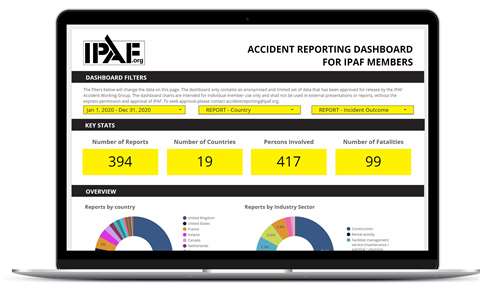
When the portal was launched in 2012, IPAF estimated it would not be until 2017-18 before the database was broad and granular enough to offer meaningful data insights. We have certainly surpassed that threshold, but are still limited by the relatively high capture ratio of fatal accidents and LTIs in relation to other more minor incidents and near-misses.
As in any system, the output is only as good as the data inputted. We must change the culture when it comes to empowering all users, operators and supervisors to report even the most minor incidents and near-misses on a daily basis.
IPAF Load and Unload training course
The occupation of delivery driver still features highly in the number of incidents reported. We know from data that this is the occupation that is potentially most at risk of an incident occurring and at risk of sustaining an injury.
There were 164 delivery drivers injured and six fatalities reported globally during this period. From the previous report, covering the period 2016-2018, data identified that delivery drivers were at risk in this way.
As a result of this the IPAF Load and Unload training course was subject to a major internal and stakeholder review. The course was subsequently updated to include the identified risks and hazards and relaunched towards the end of 2020.
In the early days of the accident reporting project, which launched in 2012-13, the majority of reports were received from the IPAF UK membership. As the project enters its second decade, reports have come from 19 countries in the most recent two years of data gathering, and more than 25 countries worldwide in the past five years.
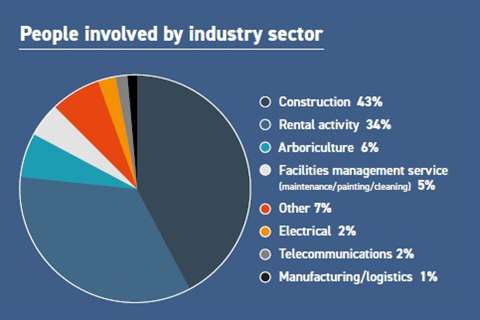
Fatal falls on construction sites
Reported data about falls from the platform shows 117 incidents involving 120 people injured and 93 killed. In terms of countries reporting the highest numbers of falls from the platform, the US was the highest followed by France and Australia respectively. The main sectors were construction and arboriculture, with facilities management and electrical applications lying third and fourth.
1b static booms were the most common machine type for this type of incident, followed by 3b mobile booms and 3a vertical lifts. Persons ejected or falling from a boom-type platform are likely to not have been using the correct personal fall protection equipment, have not attached their lanyard to the correct anchor point or used no PFPE - all against industry guidance.
PFPE is not usually recommended for use in most 3a MEWPs. Therefore it is possible to conclude that the majority of those falling from mobile vertical lifts, such as scissor lifts, are likely to have climbed on the guardrails, leant out of the platform or attempted to exit the platform at height - all against recommended guidance.
In terms of the location, the data shows that accidents at construction sites are most common. If roads/highways and public areas are combined the total number of incidents surpass construction.
This is consistent with reports from previous years, which indicated that controlled worksites (such as construction, commercial premises, warehouses and other installations) are safer than other locations that could be classed as uncontrolled, ie, not segregated from non-related activities, vehicular traffic etc.
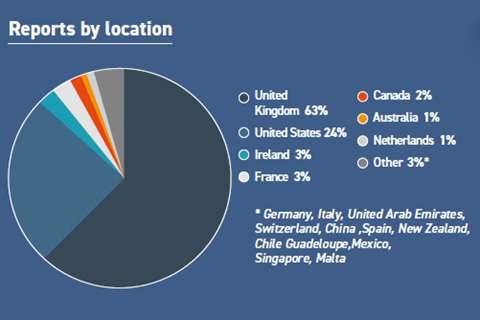
Seriousness of electrocution incident
From the data received through IPAF’s reporting portal, this type of accident almost always results in a fatality. Of the 97 reported incidents, 91 resulted in fatalities. A total of 101 people were injured or killed by electrocution while using MEWPs in the period 2016-2020.
An electrocution incident is likely to have a very serious outcome with few second chances. The majority of electrocution incidents are reported from the United States, accounting for 84% of all recorded fatal electrocutions reported during the period of 2016-2020.
In terms of industry end-use, arboriculture and electrical make up 60% of all fatal incidents. Construction and facilities management together make up just under 30% of fatalities, with telecommunications accounting for 6% of deaths by electrocution.
Electrocutions are more likely to occur away from controlled worksites such as construction, commercial, rental etc. This type of incident is most likely to occur in a public area, including near to roads, or in the management of trees and most commonly involve boom-type platforms, either vehicle or trailer-mounted or self-propelled.
Gravity of entrapment incidents
In the 2016-20 data from 15 countries there were 84 people injured and 73 killed in entrapment mishaps. As with other accident types, entrapment injuries tend to be either serious or fatal. The US and Canada are the two countries where entrapments were most prevalent.
In terms of sectors, entrapments mainly occurred in construction and then facilities management. These sites are likely to involve temporary work at height, either indoors or within structures during the erection process.
This means that MEWP operations tend to be complex and the presence of overhead hazards, such as roofs and ceilings, supporting joists, girders or steelwork that present an elevated risk of entrapments.
High risk of tip-over injury
The data shows that in terms of countries reporting that the US reported the most tip-over incidents, followed by the UK and France. Sector analysis shows that construction was the most common end use, followed by facilities management.
Common underlying causes in construction will likely include poor/unsuitable ground conditions, slopes and gradients, hidden ground hazards or collapsing ground.
Other factors are likely to include inadequate site risk assessment, underestimating load-bearing capabilities of the ground conditions or incorrect assumption that the ground will take the weight of the MEWP.
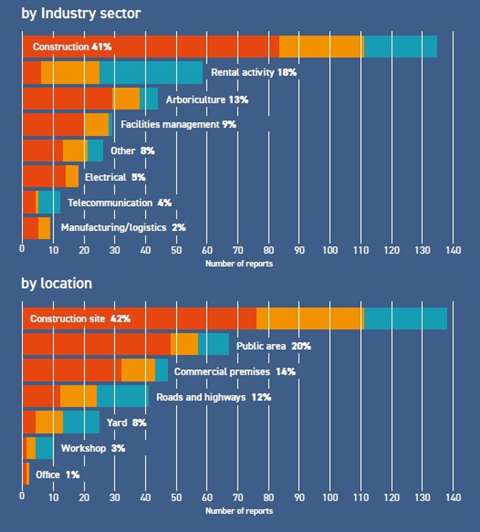
Construction is leading sector for fatalities
There were 85 reports from 10 countries of MEWPs being struck by another vehicle or machine. The 2016-2020 data revealed that of the 89 people injured, 22 ended in fatalities. Most of these incidents were reported from the UK, with the US is the country where MEWPs are most often hit on roads or in public areas.
In terms of fatalities, construction is the leading sector followed closely by facilities management. With multiple plant machines being operated on construction sites, it follows that there is heightened risk of being struck by another vehicle or machine.
In the facilities management sector, a fatality may be more likely caused by working alongside a road or in a public area and being struck by another vehicle such as a bus or HGV.
Hanging or changing advertising banners, cleaning windows, installing or repairing external air conditioning units, sign writing, fixing or inspecting external lighting etc are all common facilities management tasks and will often be conducted in a public area and/ or alongside roads.
The three main categories in descending order are 3b, 1b and 3a. This is consistent with the types of MEWP most commonly used alongside roads being boom-type platforms, either mobile or vehicle-mounted.
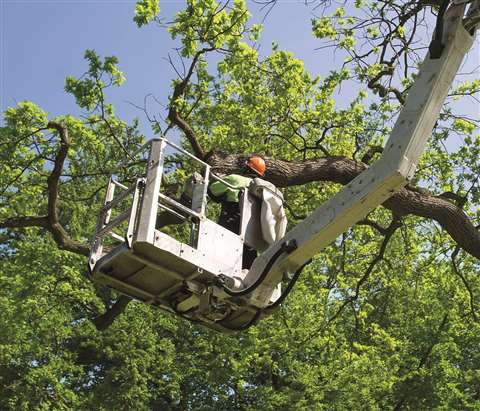 In terms of industry end-use, arboriculture and electrical make up 60% of all fatal incidents
In terms of industry end-use, arboriculture and electrical make up 60% of all fatal incidents
Protect workforce from falling objects
The 2016-2020 data shows 52 reports of MEWPs hit by a falling object or materials from eight countries, in which 55 people were injured with 21 ending in fatalities. Most incidents occurred in construction or arboriculture, on construction sites or public areas, when the machine was elevated.
A typical accident would be material from a structure being installed or repaired, falling to hit the platform, including ducting, air-conditioning components or building cladding. Likewise,
material can become unstable as a result of the task, such masonry can be dislodged during a building renovation.
Outcomes from this type of injury are not necessarily always fatal, but usually involve at least, serious injury.
A work at height risk assessment is about more than just selecting the correct machine. It also involves a rigorous site assessment, including ground conditions and weather, proximity to roads, traffic, hazards on the ground and overhead.
This ensures that the operator is adequately trained and familiarised on the equipment, and that operations are conducted and supervised according to recognised safe-work procedures.
STAY CONNECTED



Receive the information you need when you need it through our world-leading magazines, newsletters and daily briefings.
CONNECT WITH THE TEAM







